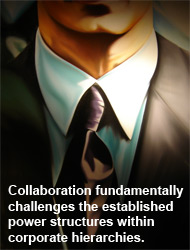Skip to the starting post of this 12 part series.

“Do your best to ensure that linear processes give way to networks of collaboration.” (From this list.)
Collaboration is powerful when enabled within a conducive culture.
Many businesses have process addiction. Companies have just about gotten used to the idea of TQM and processes. And now they are expected to think collaboration. Collaboration is togetherness. Process is “”your bit” versus “my bit”.
Collaboration also fundamentally challenges the established power structures within corporate hierarchies. It can make a royal mess of reporting rules as people switch to focusing more on getting an outcome together rather than playing by the rules.
Again, the fear of losing control raises its ugly head. The fear of losing relevance especially on the part of managers. Our work culture values busy-ness and doing. We often don’t see management as doing anything of value. Thus managers perceive they have the most to lose from a flat collaborative system.
The environment needs to be right so people feel safe enough to collaborate. Unsurprisingly, businesses look everywhere else but the central human issue for solutions. Such as lowering partitions so people can see each other. David Rock’s recent article Office buzz cuts into deep thinking on the Sydney Moring Herald is a timely illustration:
Someone had noticed that people were not collaborating much, and thought the problem was that people couldn't see each other.
The trouble is, collaboration may have less to do with being able to see other people and more to do with how people feel at work. We tend to reduce collaboration when we feel threatened or stressed, and increase it when we feel safe.
…
Unfortunately, organisations often find it easier to invest in physical, tangible changes over less certain human changes.
“Drive authority downwards. Make decisions quickly at the lowest level possible.”
Studies and research have shown that empowering employees with the authority to do their jobs the best way they know how is very effective at fostering great customer experiences and innovative solutions to problems. Any yet we have not really seen this practice deployed en masse.
Imagine the call centre service person at your local telco who is authorised to spend as much time as is needed to understand your problem, and the authority to represent your needs in asking for other actions to be taken! Would that transform the (below) average telco experience? You bet.
So why hasn’t this happen? Fear. The fear of loss of control. The fear of abuse (of course EVERYONE will abuse a good system), the fear of competitors getting ahead, and the fear of trying something new that may fail.